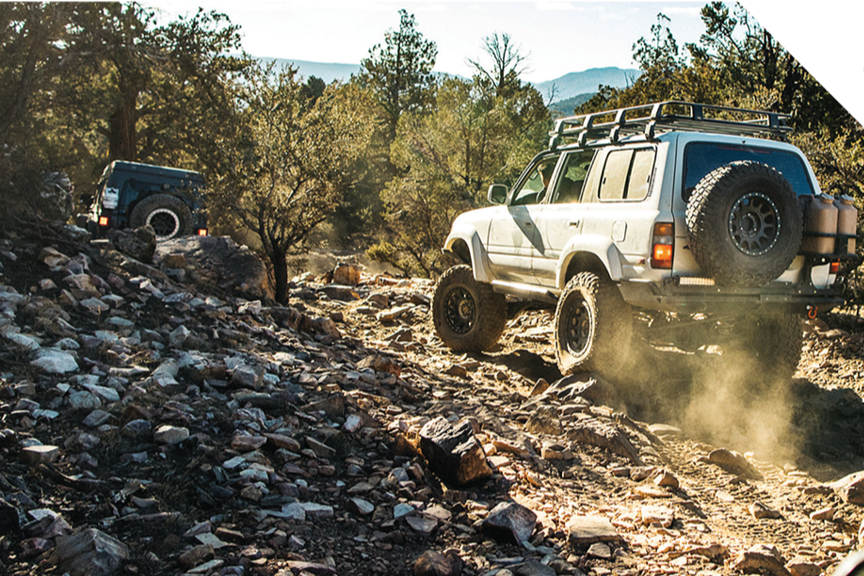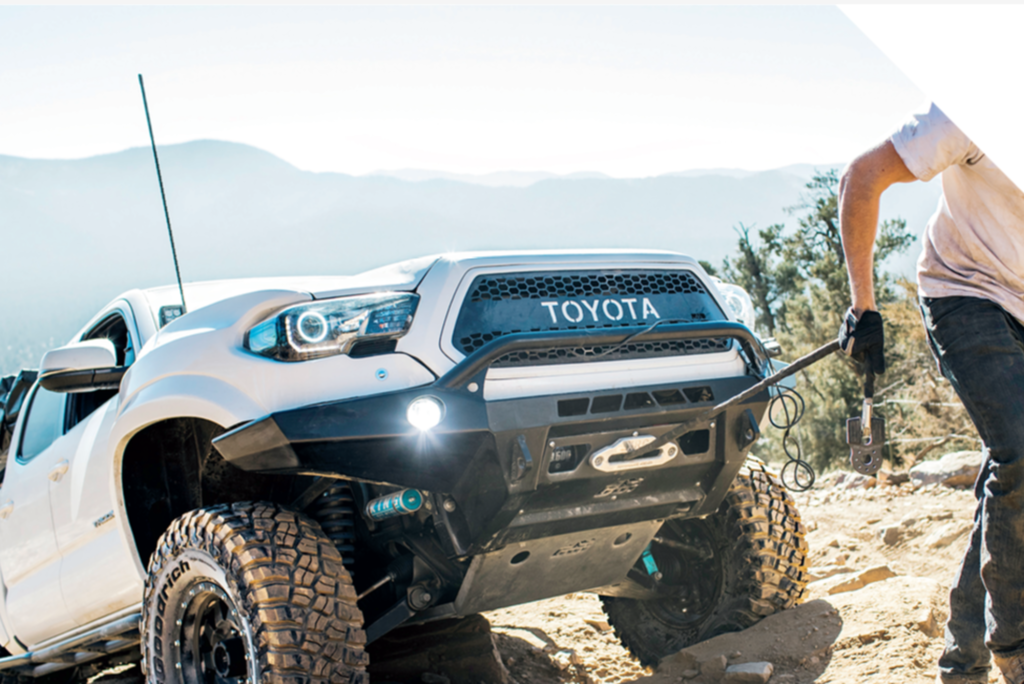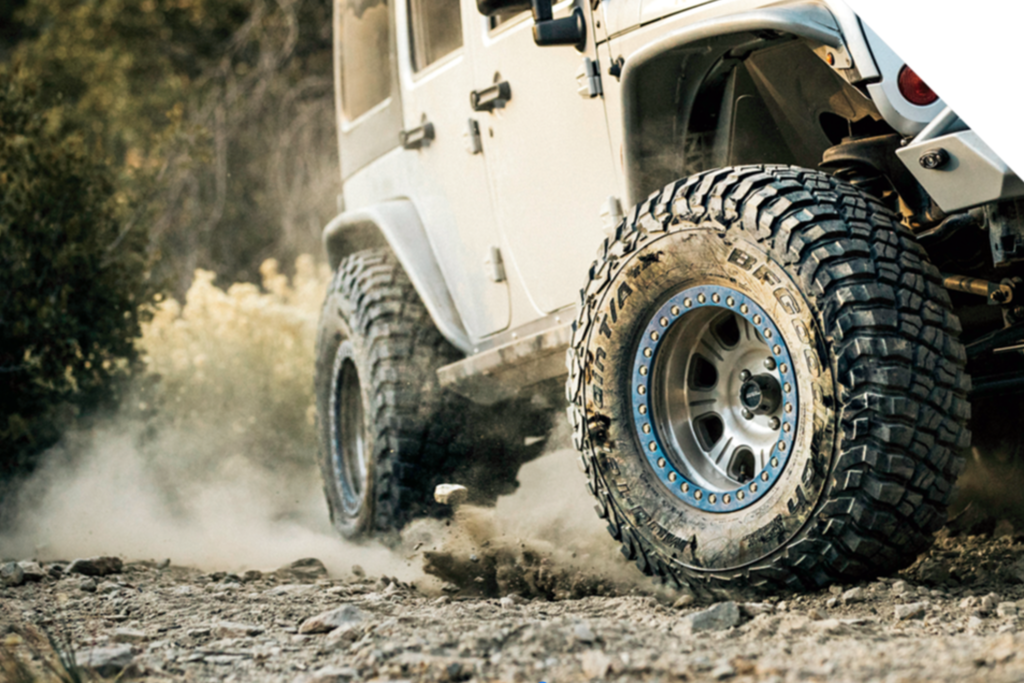Off-Road Glossary
From 4WD High to Tow Hitch, there's a lot of terminology to learn in the world of off-roading. Need to understand a off-road expression? Find all the terms you need to know in our Off-Road Glossary.
2WD – In a 2WD vehicle, two wheels receive all the torque. Operating in 2WD provides significantly better highway fuel economy.
4WD High – 4WD High gives you extra traction on dirt roads and easier trails that require steady momentum. It reduces the likelihood of slipping and spinning your wheels on surfaces like snowy roads and muddy dirt.
4WD Low – 4WD Low provides maximum traction and power to negotiate difficult terrain when slower speeds and greater torque are required. It can also be helpful when towing.
4x4 – A vehicle that has four wheels and four-wheel drive.
Acceleration – The capacity to gain speed within a short timeframe.
After-Market Modifications – Changes made to a vehicle beyond factory specifications. After-market parts may or may not be manufactured by the original equipment manufacturer.
Aired/Airing Down – Lowering the tire pressure to offer a smoother ride while driving off-highway. It also increases your tire’s footprint, resulting in better traction over rocks and loose terrain.
All-Terrain Tires – All-terrain tires are designed to provide considerable traction over a wide range of terrains. Their less aggressive tread design provides a much smoother and quieter highway ride than a mud-terrain tire.
All-Wheel Drive (AWD) – AWD vehicles utilize a center differential to deliver power to all four wheels. But most AWD vehicles don’t have a transfer case that splits and locks the power 50/50 front to back, so they will operate like front-wheel drive vehicles most of the time – only delivering torque to the rear wheels as needed.
Approach Angle – The maximum angle at which a vehicle can enter an upward slope without the front of the vehicle touching the ground.
Ascent – Driving up to the summit of a mountain or hill.
Automatic Transmission – Shifts between gears internally, freeing the driver from having to shift gears manually. An automatic transmission allows you to efficiently reach high speeds and is typically used for highway driving.
Axle – A central shaft for a rotating wheel that may be fixed to the wheels and rotating with them or fixed to the vehicle with the wheels rotating around the axle.
Axle Ratio – A comparison of the number of gear teeth on the rear axle and the pinion gear on the driveshaft.
Baja – Mexico’s Baja California Peninsula, it’s considered a mecca for off-road racing.
Bias Tire – A type of recreational light truck tire popular until the 1970s. Bias tires were tough but also incredibly stiff, prone to tire slip and designed to bulldoze rather than grip.
Biting Edges – Portions of the tire tread that is designed for increased wet and snow traction.
Bogged Vehicle – A vehicle that has become stuck in water, mud or sand.
Bottle Jacks – Also called hydraulic jacks, bottle jacks are very compact and can lift immense amounts of weight. They have less reach than traditional crank jacks.
Bow Shackle – A key equipment recovery tool shaped like a large loop to take loads from many directions without developing as much side load.
Break-Over Angle – The maximum angle at which a vehicle can drive over a ridge or obstacle without scraping its underside.
Camel Trophy – Was an annual competition held from 1980 – 2000. It was best known for its use of Land Rover vehicles over the world’s most challenging terrain.
Center Console – The control-bearing surfaces in the front center of the vehicle interior.
Clutch – A mechanism for connecting and disconnecting a vehicle engine from its transmission system.
Clutch Start Cancel Button – Allows you to start your rig with your key in the ON position without applying the clutch.
Crank Jack – A traditional device that employs a screw thread for lifting heavy equipment.
Crawl Assistance – An intuitive sensor system that is designed to control your brake and throttle in low-speed off-road driving over difficult terrain.
Crawling – Most crawling is done in low gear at a snail-like speed. We’re talking 1-3 mph.
Crest – The top or extreme point of a mountain or hill.
Dakar Rally – An annual off-road endurance event requiring amateur and professional drivers to traverse terrain much tougher than conventional rallying with true off-road vehicles rather than modified on-road vehicles.
Departure Angle – The maximum angle a vehicle can exit a downward slope without the rear coming in contact with the ground.
Descent – Moving downward, dropping or falling from the summit of a mountain or hill.
Differential – Differentials are designed to allow wheels on a single axle to move at different speeds.
Double-Line Recovery – Doubles the pulling power of your winch by running a line through a snatch block.
Driveshaft – The component in a drivetrain that transmits torque and rotation from the transmission to the differential.
Drivetrain – A group of components that delivers power to the driving wheels. This excludes the engine or motor that generates the power. In contrast, the powertrain is considered to include both the engine or motor and the drivetrain.
Engine Braking – Using the retarding forces within an engine to slow down a vehicle, as opposed to using additional external braking mechanisms like friction brakes or magnetic brakes.
Flotation – Putting more of the tire’s rubber in contact with the ground, enabling them to “float” atop loose terrains like sand, mud and loose clay.
Footprint – The portion of the tire’s tread that touches the road’s surface.
Fording – Crossing a river or stream at a shallow place.
Fording Depth – The maximum depth of water a vehicle can pass through at a given speed without ingesting water into the motor.
Four-Wheeling – Driving a four-wheel drive vehicle off-road and through extreme conditions.
Four-Wheel Drive – Putting your vehicle into four-wheel drive distributes torque and traction to all four wheels to help limit the chances of your vehicle getting stuck.
Full-Time 4WD – Also called permanent 4WD, full-time 4WD is a system that powers all four wheels at all times.
Gear – Transmits power from the crankshaft (the rotating axle that takes power from the engine) to the driveshaft running under the car that ultimately powers the wheels.
Gear Shift – Used to engage or disengage gears in a vehicle transmission.
Ground Anchor – Can be buried in the ground to serve as a winching anchor point.
Ground Clearance – Also called ride height, it’s the distance between the lowest part of the vehicle and the ground or obstacle to be cleared.
Gully – A landform created by rushing water that sharply erodes the soil, typically on a hillside. Gullies resemble large ditches or small valleys, but are meters to tens of meters in depth and width.
Handling – The way your vehicle responds and reacts to driver input, as well as how it moves along a track or road.
Hi-Lift Jack – Designed for vehicles with lift kits, it offers higher clearance for repairs or recovery.
High-Flotation Tire – Flotation tires have a much wider footprint than LT-metric tires, putting more of the tire’s rubber in contact with the ground to “float” atop loose terrains. Many all-terrain and mud-terrain tires have high-flotation sizes available.
Highway Use – The ability to drive an off-road vehicle on a paved road.
Idle – When the engine is running with no throttle input.
Independent Front Suspension – a vehicle suspension system where each wheel acts independently of one another.
Jack – A tool that allows you to lift a car off the ground in order to make repairs or change a tire.
Jacking Points – Areas where you can safely use a jack. Identified by your vehicle manufacturer.
Kinetic Energy – The energy created by being in motion.
Kinetic Recovery Rope – A recovery method that uses stretchy, high-tencity nylon rope to sling a bogged vehicle free – like a rubber band.
King of the Hammers – An off-road race that combines desert racing and rock crawling. Held in February on Means Dry Lake at Johnson Valley, California.
Left-Foot Braking – A technique that uses both feet to help control your speed over difficult obstacles.
Lift Kit – Lifts the suspension of the vehicle to allow for larger diameter tires. Provides more ground clearance to improve your vehicle’s ability to overcome obstacles.
Lift Mates – Hook attachments to lift the wheel.
Limited-Slip Differential – Redirects torque to the tires with the most traction to help your vehicle move forward over difficult terrain.
Line Dampener – Placed over the winch cable to slow it down in case it snaps. Could be a blanket, coat or even a floor mat.
Load Range – The tire’s ability to hold air pressure and carry weight. You’ll find the load range listed on the tire sidewall represented by a letter. This letter code gives you a comparative idea of the tire’s toughness; helping you understand how much air your tire can hold and how much weight it can carry, it’s a relative measure of the tire’s durability. Tires with higher load ranges carry heavier loads.
Locker – An axle mechanism for locking differentials.
Locking Differential – Allows wheels on a single axle to lock and spin at the same rate. Equal power is distributed to both wheels, regardless of traction.
LT Tires –If a tire size begins with LT, it signifies the tire is a light truck metric size designed for vehicles capable of carrying heavy cargo or towing large trailers.
Manual Transmission – Manual transmissions require a clutch and manual gear selection, allowing more individual control of the vehicle.
Momentum – The built up motion your vehicle needs to power through loose terrain.
Mud-Terrain Tires – Feature large tread blocks and voids to effectively evacuate mud and soft soil while maintaining traction on rocky and uneven trails.
No-Man’s-Land – A place unoccupied due to fear or uncertainty.
Obstacles – Rocks, logs and other items obstructing your path.
Off-Road – The appropriate trails that are no paved, that you are allowed to take your vehicle on.
Off-Roading – Driving a vehicle on unsurfaced roads or trails made of sand, gravel, riverbeds, mud, snow, rocks, and other natural terrain. Types of off-roading range in intensity, from leisure drives with unmodified vehicles to competitions with customized vehicles and professional drivers.
Open Differential – Allows wheels on a single axle to move at different speeds. The torque flow in open differential will take the path of least resistance, so it will go to the wheel with the least amount of traction.
Original Equipment (OE) – Parts you get to match those that were on your vehicle when it left the manufacturer.
Overlanding – Self-reliant adventure travel to remote destinations where the journey is the primary goal.
P-Metric Tires – Tires designed for passenger vehicles and meant for highway use only. They are not suitable for off-road.
Pack It In, Pack It Out – Don’t leave anything behind – ever. We only have one Earth, so you better treat it right.
Parking Brake – A brake used to hold a stationary vehicle in place.
Part-Time 4WD – Also called on-demand 4WD, part-time 4WD is a system that allows 4WD to be called upon when needed.
Prerun – Running the course before the start of the race.
Push-Start – Starting your engine by engaging the manual transmission while the vehicle is in motion. Used when other starting methods are unavailable.
Radial Tire – The sidewall and tread function as two independent features of the tire for better mileage and treadlife.
Recovery Boards – Lightweight ramps designed to help you regain traction in soft terrains like sand and mud.
Recovery Points – Tow points for off-road recovery.
Recovery Strap – A strap often made of flat nylon webbing with open loops that can be used to pull out a bogged vehicle.
Rim – The outer edge of a wheel that holds the tire.
Rock Crawling – Moving in a low gear at a slow speed to drive up, down and across obstacles.
Roll Bar – A metal bar running up the sides and across the top of a vehicle that strengthens its frame. This is imperative for your safety in the event that your soft-top vehicle flips.
Rollover Angle – The maximum angle a driver can drive a side hill without turning over.
Roof Rack – Provides additional storage for tools and gear needed for many types of off-road adventures.
Rut – A long deep track made by the repeated passage of the wheels of vehicles.
SCORE (Southern California Off Road Enthusiasts) – An off-road racing sanctioning body in the sport of desert racing famous for the Baja 500, Baja 1000 and San Felipe 250.
Side Hill – Driving laterally across the face of a hill. This greatly increases your risk of rolling over.
Sidewall – The area of a tire between the tread shoulder and the rim bead. Thick sidewalls add toughness so you can take on all but the most extreme trails.
Single-Line Recovery – Also called self-recovery, a basic winching technique where a driver uses a large anchor to pull their vehicle free.
Sipe – A groove or channel in the tread of a tire improves its grip. More sipes increase the number of biting edges for more traction in winter conditions.
Snatch Block – A pulley used in conjunction with a winch in a recovery application that increases pull power over short distances. It also allows you to change the direction of your winch’s cable when the anchor point is offset.
Soft-Top Vehicle – A vehicle with a roof made of fabric (rather than metal) that can be folded down or removed.
Solid Front Axle – A single, solid shaft that connects a set of wheels.
Spooling – Proper retraction of a recovery rope from a winch. Take time to inspect that the winch is spooling properly. Take periodic breaks to make sure that the motor of an electric winch won’t overheat.
Spotter – Someone outside the vehicle who can you help find the proper line when it’s difficult for you to see. A trusted spotter can save you from injuring yourself or committing costly damage to your vehicle.
Stall-Start Recovery – A technique for safely restarting a manual transmission vehicle on a steep hill.
Steering Column – The shaft that connects the steering wheel to the rest of the steering mechanism.
Straddling – Keeping your wheels on both sides of ruts or gullies as you drive.
Suspension – A system of springs and shock absorbers that cushion a vehicle from road conditions, including a system to smooth out bumps, keep tires touching the road and control vehicle stability.
SUV (Sport Utility Vehicle) – A vehicle with off-road features like raised ground clearance and ruggedness, and available four-wheel drive. Many SUVs are built on a light-truck chassis but operated as family vehicles, and though designed to be used on rougher surfaces, most often used on city streets or highways.
Synthetic Rope – While it’s susceptible to chafe, this industry standard has a much higher breaking point and is safer than traditional steel cable.
Terrain – The physical features of a specific stretch of land.
Three-Point Turn – Turn a vehicle around in a tight space by moving forward, backward and forward again.
Throttle – A device controlling the flow of fuel or power to the engine.
Tire Pressure – The amount of air inside a tire. Affects the performance of your vehicle.
Torque – The rotating force created by the engine’s crankshaft. An engine with higher torque is better suited for climbing and crawling over obstacles.
Tow Hitch – Device such as a tow ball attached to the chassis of a vehicle for towing.
Tow Strap – A piece of recovery gear used to pull loose a stuck vehicle.
Traction – The tire’s ability to grip surfaces.
Traction Control – A system designed to prevent loss of traction by keeping the vehicle moving forward by alerting the computer to brake as necessary in order to keep the wheels from spinning and losing traction. It may have a simple on/off switch or come with multiple settings.
Trail – Unsurfaced roads or tracks other than paved roads and maintained dirt roads that can include sand, gravel, riverbeds, mud, snow, rocks, and other natural terrain.
Trail Ratings – To help drivers choose the right trail for their abilities, Jeep Jamboree USA labels many trails with a number and colored shape to distinguish how challenging they’re likely to be.
Transfer Case – Transfers power from the driveshaft to the front and rear axles.
Transmission – Transfers power from the engine to the wheels. An automatic transmission changes gears without driver input. A manual transmission allows the driver to control shifting.
Transmission Wind-Up – The stress or torque created in the components of a vehicle when it is placed in four-wheel drive and driven around corners.
Tread – The part of the tire that makes contact with the road or ground to give you traction to move forward.
Tread Block – Independent areas of tread around the tire’s circumference. Multiple side-by-side rows of tread blocks are typically molded across a tire’s tread.
Tread Lightly – A U.S. nonprofit organization with the mission “to empower generations to enjoy the outdoors responsibly through stewardship to further the goals of responsible and ethical recreation.
Treadwear – How quickly and evenly the tread on your tires wears out.
Tree Strap – An essential item in any winch recovery kit that allows you to winch from a wide variety of anchor points.
Undercarriage – The supporting frame under the body of a vehicle.
Void – The gaps between the raised tread blocks on your tire that allow the tire to flex slightly, improving traction and handling. These gaps direct water, mud and snow away from the tire, which helps prevent hydroplaning and keeps you gripping the road.
Wheel – A wheel is comprised of a tire, rim and hubcap.
Whip – A flag or a light that extends up past the roof of your vehicle to allow drivers on the other side of a dune or hill to know your location.
Winch/Winching – A winch is a heavy-duty cable attached to a powered rotating drum that can pull large vehicles. A vital tool for off-roaders.
NEED MORE HELP TO PLAN A TRIP
Our Trip Planning section gives lots of helpful information to get you started.






